Discover how the Organic Acids Test can transform your health and guide you toward long-term wellness.
If you’ve ever wanted to get a baseline of your health but felt lost on where to start, you’re not alone. Many people leave their annual check-ups feeling like they didn’t get enough answers—just a quick conversation, some basic bloodwork, and a “see you next year.” But what if there was a way to take a deeper dive into your health and uncover hidden imbalances before they turn into bigger problems? That’s where the Organic Acids Test (OAT Test) comes in.
This comprehensive urine test provides an in-depth look at your gut health, energy production, nutrient levels, and even how well your body is detoxifying. Whether you’re dealing with chronic symptoms or just want to optimize your wellness, the OAT Test is one of the best tools to truly understand what’s happening inside your body—and more importantly, how to improve it.
What Is the Organic Acids Test (OAT Test)?
The Organic Acids Test, commonly known as the OAT Test, is a comprehensive urine analysis that evaluates over 70 markers to assess your overall health. There are a few manufacturers of OAT tests, but we’re diving into Mosaic ‘s (formerly known as Great Plains Labs.) This test identifies imbalances related to:
- Gut health (bacterial, yeast, and fungal overgrowth)
- Nutritional deficiencies
- Detoxification capabilities
- Neurotransmitter levels
- Oxidative stress
It’s a powerful tool for uncovering hidden health issues that might not show up on standard lab tests.
Why Is the Organic Acids Test a Good Indicator of Overall Health?
The OAT Test provides a big-picture view of your body’s internal environment. Here’s why it’s invaluable:
- Gut Health Connection: Detects yeast and bacteria that could lead to digestive issues, fatigue, and mental health challenges.
- Energy Production: Reveals mitochondrial dysfunction, helping you understand energy issues or chronic fatigue.
- Nutrient Status: Identifies deficiencies in vitamins and antioxidants essential for overall wellness.
- Mental and Emotional Health: Highlights neurotransmitter imbalances tied to anxiety, depression, and brain fog.
- Toxin Exposure: Shows whether your body is effectively removing harmful environmental toxins.
When you address these areas of imbalance, your overall health improves, often leading to relief from symptoms you’ve struggled with for years.
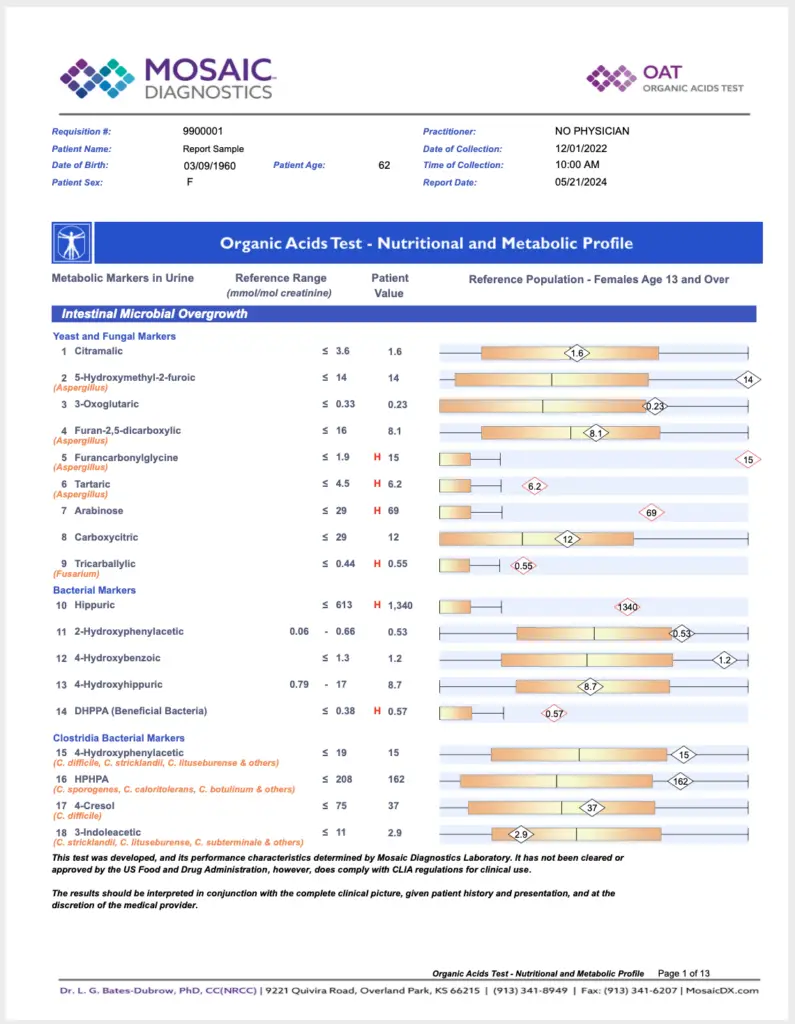
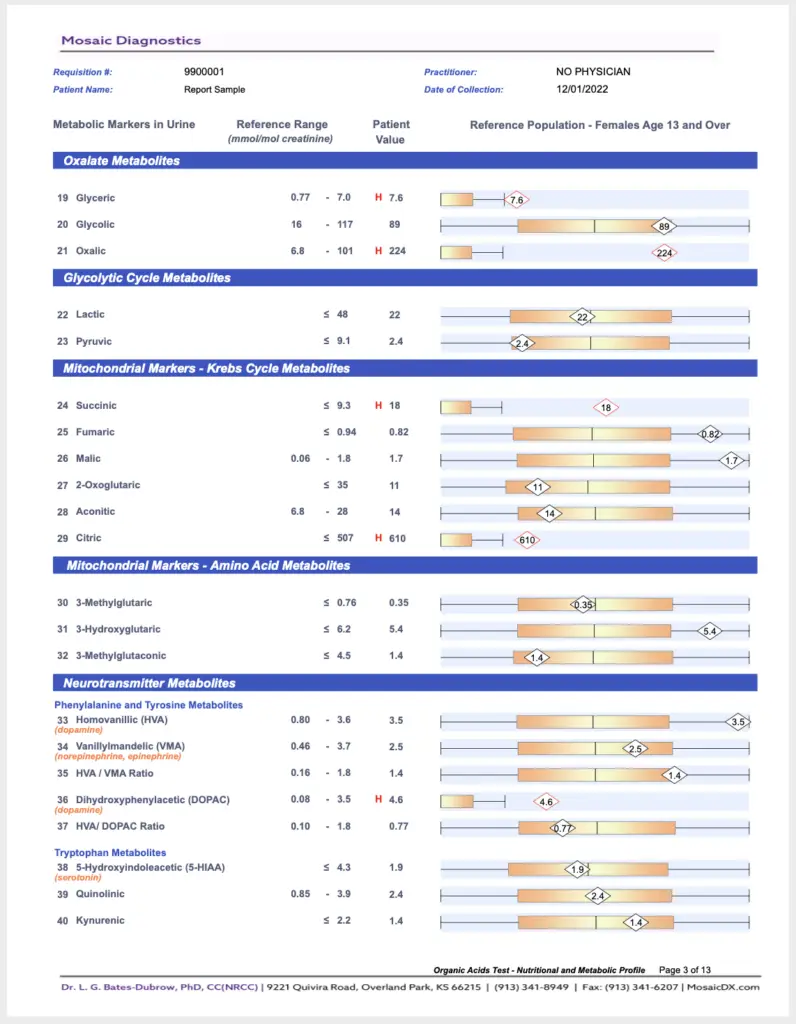
What Does the Organic Acids Test Measure?
Here is a more in-depth look at what this test specifically covers:
- Intestinal Microbial Overgrowth markers assess the presence of candida activity, toxins from clostridia bacteria, possible mold exposure, and imbalances within the gut microbiome.
- Oxalate Metabolites help determine oxalate levels produced by microorganisms in the body or influenced by dietary intake.
- Glycolytic Cycle Metabolites and Mitochondrial Markers (including Krebs Cycle and Amino Acid Metabolites) analyze metabolic efficiency, specifically how glucose and amino acids are utilized for energy, while also identifying potential mitochondrial dysfunction.
- Neurotransmitter Metabolites examine the metabolism of phenylalanine, tyrosine, and tryptophan, which play key roles in neurotransmitter balance and the production of quinolinic acid.
- Pyrimidine Metabolites & Ketone and Fatty Acid Oxidation markers provide insight into folate levels and cellular turnover, while also evaluating how effectively mitochondria use fatty acids for energy.
- Nutritional Markers assess the adequacy of essential vitamins, antioxidants, and cofactors involved in metabolic pathways.
- Indicators of Detoxification evaluate oxidative stress by measuring glutathione levels and assessing the function of methylation and transsulfuration pathways.
- Amino Acid Metabolites can indicate a potential need for specific nutrients or may signal underlying genetic metabolic disorders if certain analytes remain consistently elevated.
- The Mineral Metabolism marker offers insight into phosphate intake through diet and may also provide clues about Vitamin D levels.
The 76 Organic Acids that the OAT Test measures:
- Citramalic Acid
- 5-Hydroxymethyl-2-furoic Acid
- 3-Oxoglutaric Acid
- Furan-2,5-dicarboxylic Acid
- Furancarbonylglycine
- Tartaric Acid
- Arabinose
- Carboxycitric Acid
- Tricarballylic Acid
- 2-Hydroxyphenylacetic Acid
- 4-Hydroxyphenylacetic Acid
- 4-Hydroxybenzoic Acid
- 4-Hydroxyhippuric Acid
- Hippuric Acid
- 3-Indoleacetic Acid
- Succinic Acid
- HPHPA (Clostridia marker)
- 4-Cresol (C. difficile)
- DHPPA (beneficial bacteria)
- Glyceric Acid
- Glycolic Acid
- Oxalic Acid
- Lactic Acid
- Pyruvic Acid
- 2-Hydroxybutyric Acid
- Fumaric Acid
- Malic Acid
- 2-Oxoglutaric Acid
- Aconitic Acid
- Citric Acid
- Homovanillic Acid (HVA)
- Vanillmandelic Acid (VMA)
- HVA/VMA Ratio
- 5-Hydroxyindoleacetic Acid (5-HIAA)
- Quinolinic Acid
- Kynurenic Acid
- HVA/DOPAC Ratio
- Dihydroxyphenylacetic (DOPAC)
- Uracil
- Thymine
- 3-Hydroxybutyric Acid
- Acetoacetic Acid
- 4-Hydroxybutyric Acid
- Ethylmalonic Acid
- Methylsuccinic Acid
- Adipic Acid
- Suberic Acid
- Sebacic Acid
- Methylmalonic Acid (Vitamin B12)
- Pyridoxic Acid (Vitamin B6)
- Pantothenic Acid (Vitamin B5)
- Glutaric Acid (Vitamin B2-Riboflavin)
- Ascorbic Acid (Vitamin C)
- 3-OH-3-Methylglutaric Acid (Vitamin Q10/CoQ10)
- N-Acetylcysteine (Glutathione precursor and chelating agent)
- Methylcitric Acid (Vitamin H-Biotin)
- Pyroglutamic Acid
- Orotic Acid
- 2-Hydroxyhippuric Acid
- 2-Hydroxyisovaleric Acid
- 2-Oxoisovaleric Acid
- 3-Methyl-2-oxovaleric Acid
- 2-Hydroxyisocaproic Acid
- 2-Oxoisocaproic Acid
- 2-Oxo-4-methiolbutyric Acid
- Mandelic Acid
- Phenyllactic Acid
- Phenylpyruvic Acid
- Homogentisic Acid
- 4-Hydroxyphenyllactic Acid
- N-Acetylaspartic Acid
- Malonic Acid
- 3-Methylglutaric Acid
- 3-Hydroxyglutaric Acid
- 3-Methylglutaconic Acid
- Phosphoric Acid
Who Should Take the OAT Test?
The Organic Acids Test is ideal for anyone looking to optimize their health, but it’s particularly beneficial for those experiencing:
- Unexplained fatigue or low energy
- Chronic digestive issues (like bloating or IBS)
- Anxiety, depression, or mood swings
- Autism or ADHD symptoms
- Brain fog or memory issues
- Persistent skin problems like eczema or acne
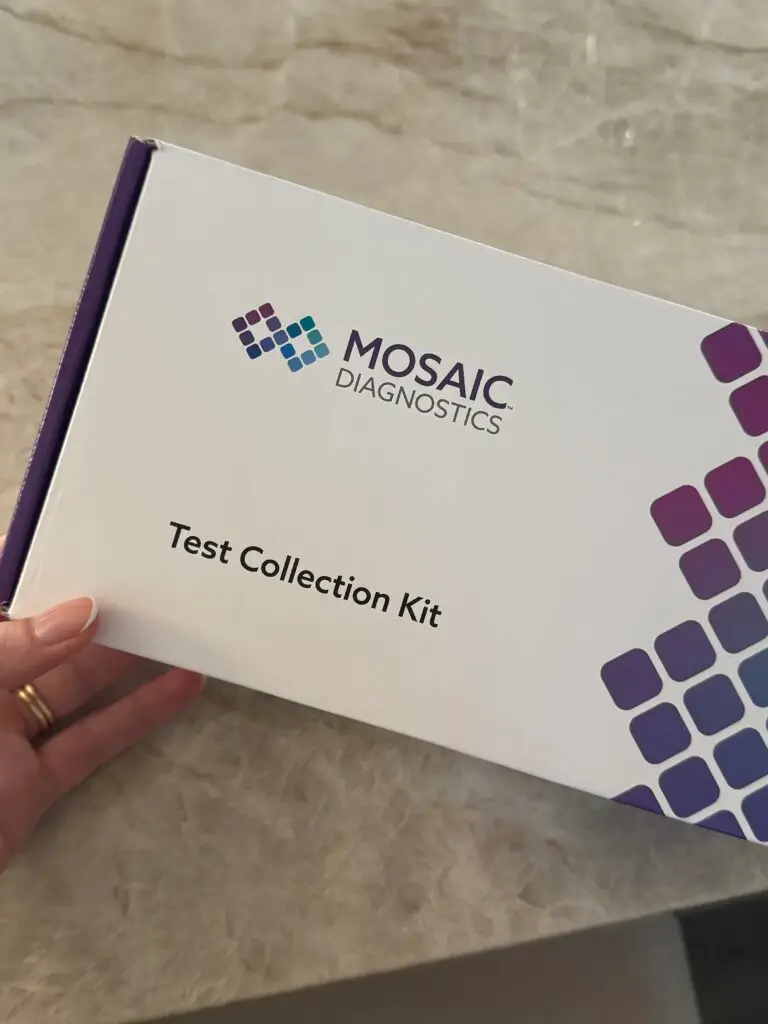
What to Expect During the OAT Test Process
If you’re considering the OAT Test, here’s what the process typically looks like:
Consultation: Your practitioner will assess your symptoms and recommend the OAT Test if appropriate.
Sample Collection: The test involves a simple urine sample that you collect at home. The test typically comes with a pre-labeled package for you to drop off at FedEx or UPS.
Analysis: The sample is then sent to a specialized lab for analysis. Results typically take a few weeks and will be uploaded to their website and sent to your practitioner.
Results and Recommendations: Your practitioner reviews the results with you, and should offer tailored recommendations for supplements, diet changes, and lifestyle shifts.
Is the Organic Acids Test Worth the Investment?
The test can cost anywhere around $300 (which typically doesn’t include the initial visit to the practitioner that has to order the test for you.) But here’s why we think it’s a smart investment for your health:
- Comprehensive Insight: The OAT Test looks at multiple systems in the body, helping you identify and address root causes of chronic symptoms.
- Personalized Recommendations: The test results are tailored to you, guiding dietary, supplement, and lifestyle changes for optimal health.
- Preventative Health: By identifying imbalances early, the OAT Test helps prevent long-term health complications.
- Efficiency: Instead of piecing together results from multiple tests, the OAT Test provides a single, detailed report.
The insights gained from the OAT Test can save you time, money, and frustration in the long run, as it helps you make targeted changes that yield real results.
FAQs About the Organic Acids Test
How much does the Organic Acids Test cost?
The cost typically ranges from $300 to $500, depending on the practitioner and lab used. While it’s an investment, the comprehensive insights are well worth it. This price usually does NOT include the cost of your appointment with your practitioner.
Is the OAT Test covered by insurance?
In most cases, it is not covered by insurance. However, Health Savings Accounts (HSAs) or Flexible Spending Accounts (FSAs) may be used to cover the cost.
How long does it take to get results?
Results usually take 2–3 weeks after the lab receives your sample.
Can the organic acids test diagnose specific conditions?
While the OAT Test isn’t a diagnostic tool, it identifies markers that correlate with imbalances and health issues, helping guide further testing or treatment.
Can I do this myself without a practitioner?
How to Find a Practitioner Who Offers the Organic Acids Test
Finding a qualified practitioner is key to getting the most out of the Organic Acids Test. Here’s how to find the right fit:
- Look for Holistic or Functional Medicine Practitioners. Search for professionals specializing in holistic or functional medicine. These practitioners often incorporate the OAT Test into their diagnostic process.
- Check Credentials and Expertise. Choose someone with experience interpreting OAT Test results. Certifications in functional medicine or advanced training in nutrition and gut health are strong indicators of expertise.
- Seek Personalization. Make sure the practitioner offers personalized treatment plans based on your test results. A cookie-cutter approach won’t maximize the benefits of the OAT Test.
- Read Reviews and Testimonials. Look for reviews from patients who have had success with their practitioner, especially those who underwent the OAT Test.
- Use Online Directories. The OAT Test manufacturer’s website – Mosaic Health – can help you find a practitioner near you.
Is the Organic Acids Test Right for You?
The Organic Acids Test is one of the most comprehensive tools available for evaluating your overall health. Whether you’re struggling with chronic symptoms or want to take a proactive approach to wellness, the OAT Test offers valuable insights that can transform your health journey.
Investing in the OAT Test is an investment in your long-term health. Take the first step by finding a holistic or functional medicine practitioner who can guide you through the process and help you uncover the root causes of your symptoms.
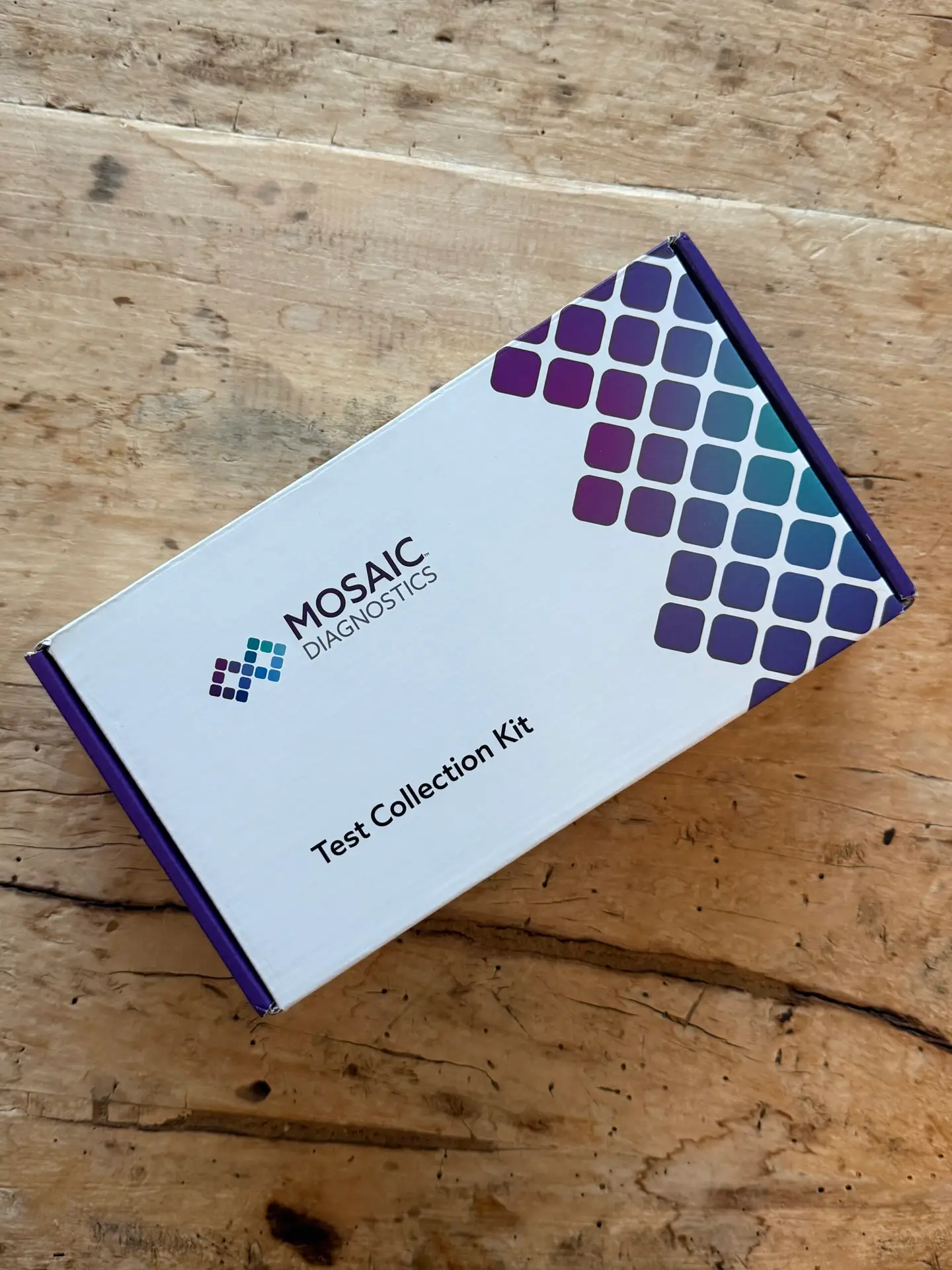




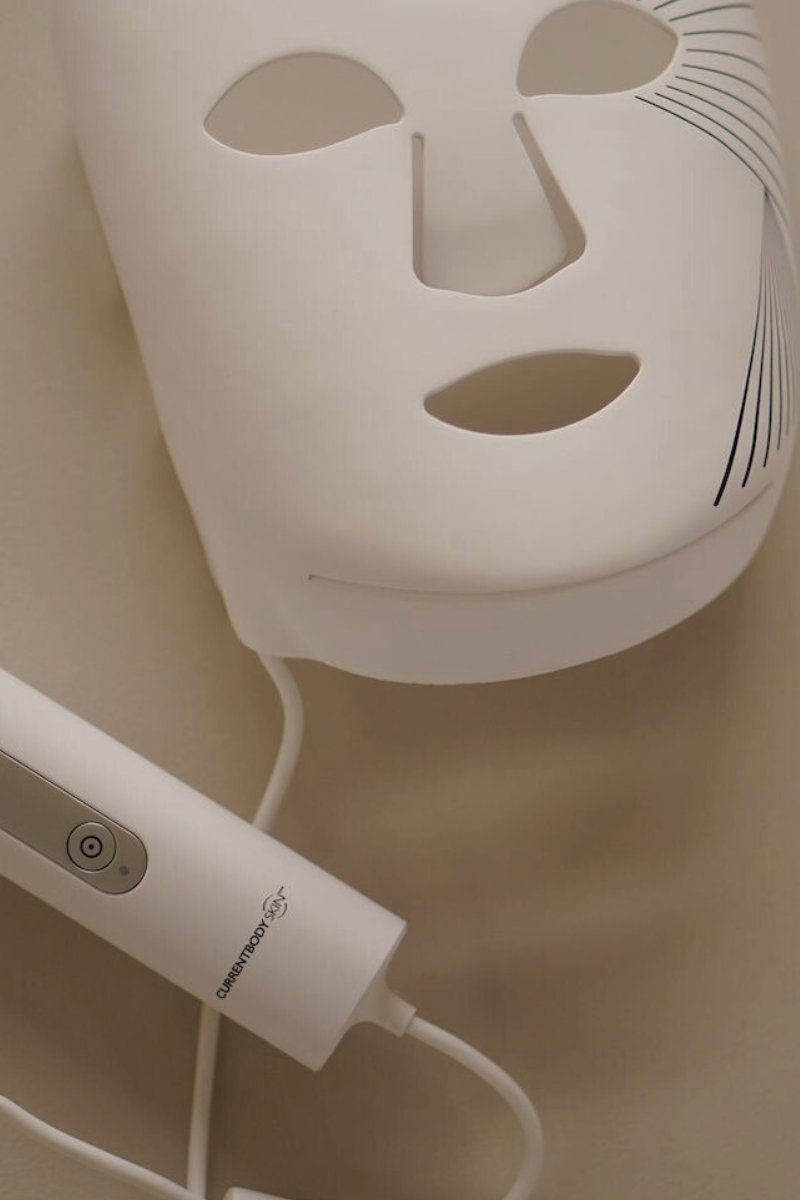
Comments +